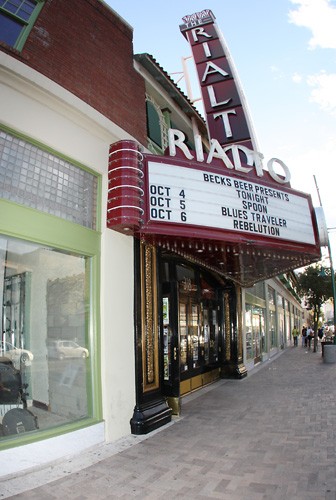What kind of birthday present can you buy for a building as eccentric as the Rialto Theatre?
Since its 1920 opening, the theater has fostered vaudeville revues, debuted silent films, worn the Paramount banner, been a hotbed for Spanish-language cinema and been contracted for furniture storage. It’s even dabbled in porno.
Even now with its power to draw some of the biggest modern bands on the touring circuit (just last month it hosted The Smashing Pumpkins), it’s hard to separate the Rialto from its long, unusual history. This Friday’s 90th birthday celebration will be a testament to that history and to Tucson’s ever-expanding place in the artistic world.
A Blast for the Past
Doug Biggers, executive director of the Rialto Theatre Foundation, has had a lot on his plate recently. Following complaints about the theater’s display of a New Pornographers mural and a bankruptcy scare, it’s little wonder why the Rialto is celebrating its birthday with a casual showcase of Tucson arts, past and present.
“”It’s a low-key birthday,”” Biggers said. “”If it was our hundredth, we’d probably be going all-out.””
The birthday celebration is a joint effort by the Rialto Theatre Foundation and the Tucson Historic Preservation Foundation. In the spirit of the Roaring ’20s, the anniversary will begin Friday night with a “”Prohibition Parking Lot Cocktail Party,”” featuring live jazz music and a fashion showcase of vintage western-wear. Guests are encouraged to dress for the part, too.
But the main event of the evening will be a screening of “”The Mine with the Iron Door,”” a story of love and gold that is as ingrained in Tucson history as creosote. Here’s why:
- The silent film premiered at the Rialto in August of 1924, when the theatre was a majestic movie palace in a mostly desolate downtown.
- The film’s international distribution made Tucson known as a tourist Eden across the globe.
- The film was shot on location in the Canada del Oro, near the Northern Santa Catalina mountains. It was an unprecedented shoot that would inspire the film boom that eventually led to the construction of Old Tucson Studios in 1939.
- The film was based on a novel by Harold Bell Wright, a bestselling Tucson author whose shadow can still be seen all over town. His name is engraved on the cornerstone of the Temple of Music and Art.
- The Tucson Historical Preservation Foundation crossed oceans to find a copy.
The old-school film will be given a new-school polish with original musical accompaniment composed by Brian Holman. It will be performed at Friday and Sunday’s screenings by a quintet made up of locals, including UA students Aaron Feeney (cello), Charles Zoll (piano), and Philip Felix (conductor). Also on the bill is recent graduate Janine Piek (violin), and local pros Christine Harper (flute) and John Snavely (clarinet).
A silent film screening might seem like an odd choice to celebrate a 90-year-old venue that has been anything but quiet. According to Biggers, it isn’t the oddest choice.
“”I had floated the idea of doing a midnight showing of ‘Deep Throat’,”” Biggers laughed.
“”Maybe for our hundredth.””
How the West was (Re)won
Demion Clinco has been president of the Tucson Historical Preservation Foundation for about three years and in that time has made a robust effort “”to preserve Tucson’s unique architectural environment.”” His partnership with the Rialto began only recently, but he has long respected what the building stands for.
“”The Rialto is a terrific example of adaptive reuse at a historic building. It really reflects how Tucson is changing,”” Clinco said.
Clinco started looking for copies of “”The Mine with the Iron Door”” a little over a year ago as a sort of side-project to the Foundation’s daily duties. The Rialto’s birthday was not even a consideration during Clinco’s early research. He simply wanted to recover a lost piece of Tucson history.
“”Only about 10 percent of silent films of the era have survived,”” Clinco said. “”We thought that ‘The Mine with the Iron Door’ was part of that 90 percent that got lost, packed away, forgotten, deteriorated or just discarded.””
Fortunately, it wasn’t. After contacting film archives around the world, Clinco found extant prints of “”Iron Door”” in two of them. The Moscow National Film Archive was first to respond, but was unable to guarantee the quality of the print. Soon afterward, the Archives Francais du Film in Paris responded as well, promising an intact digital transfer of the original film stock.
The file was not immediately watchable, though — at least not for Americans. The soundtrack was lost, and the remaining intertitles were all in French. Of the original 80 minutes of film, 25 had also been lost or cut in the span of decades, leaving some pacing problems in the transfer.
Clinco took his new digital copy to a local production company to translate the intertitles and fix the film’s pacing. Because no original score was available for the musical accompaniment, Clinco turned to another friend: composer Brian Holman.
After almost two months of “”working away furiously,”” according to Clinco, Holman produced close to 150 pages of sheet music to accompany the new version of the film. The new score is inspired by the music of early cinema as well as spaghetti-Western opera like Puccini’s “”The Girl of the Golden West,”” but is otherwise a Holman original.
A labor of more than 12 months and 5000 miles, this unique screening of “”The Mine with the Iron Door”” is a piece of Tucson history not to be forgotten.









